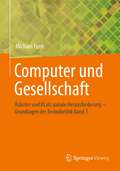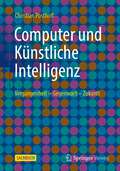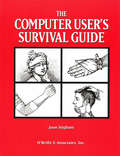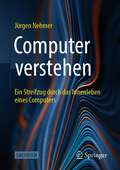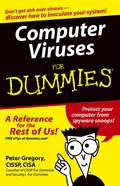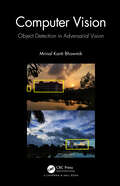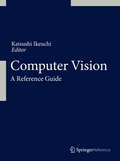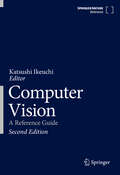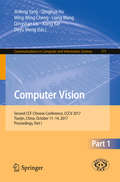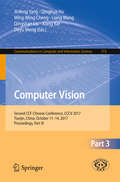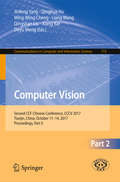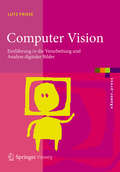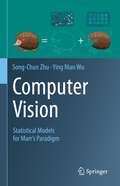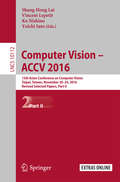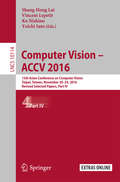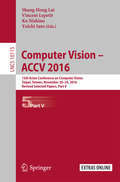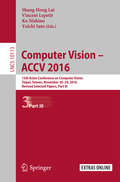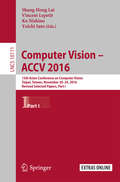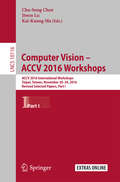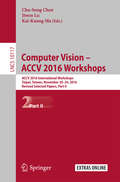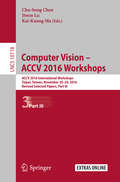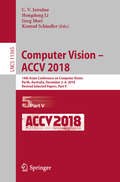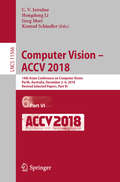- Table View
- List View
The Computer Teacher From The Black Lagoon
by Mike Thaler Jared LeeA boy contemplates all the horrible stories he has heard about the computer teacher, Miss Pluggins, and the ordeals she forces her students to endure.
Computer und Gesellschaft: Roboter und KI als soziale Herausforderung – Grundlagen der Technikethik Band 3
by Michael FunkWelche Wirkungen haben Robotik und Künstliche Intelligenz (KI) auf die Gesellschaft? Wie verändern Algorithmen und Machine Learning unser soziales Umfeld? Vor welchen ethischen Herausforderungen stehen wir? Vorliegendes Buch bietet zu diesen und weiteren Fragen systematische Analysen. Allgemeine und spezielle Roboterkonzepte von Androiden über Social Robots bis hin zu kollaborativen Industrierobotern werden vorgestellt. Hinzu treten Drohnen im militärischen und zivilen Einsatz sowie diverse Formen der Mensch-Maschine-, Tier-Maschine- und Pflanze-Maschine-Interaktion. Verschiedene Begriffe und Paradigmen der KI werden auch abseits der Informatik herausgearbeitet, reale und spekulative Entwicklungen eingeordnet. Vor diesem Hintergrund geraten ethisch-gesellschaftliche Brennpunkte in den Blick. Beispiele, Aufgaben, vertiefende Infos zu Hintergründen und Übersichten laden zum kritischen Weiterdenken ein. Es bildet den dritten, in sich abgerundeten Teil der Buchreihe Grundlagen der Technikethik.Haben wir die Zukunft, die wir brauchen, und brauchen wir die Zukunft, die wir haben?
Computer und Künstliche Intelligenz: Vergangenheit - Gegenwart - Zukunft
by Christian PosthoffDas Buch beginnt mit einer Erklärung der menschlichen Intelligenz und der Beschreibung von Intelligenztests. Die Künstliche Intelligenz, die auf Computerprogrammen beruht, beginnt mit der Dartmouth – Konferenz 1956, an der sich berühmte Informatiker dieser Zeit beteiligten. Diese damit eingeleitete Entwicklung wurde von großen Fortschritten der Kybernetik und der Spieltheorie begleitet.Es folgen Beschreibungen wichtiger Methoden und Anwendungen:Maschinelles Lernen und Neuronale Netze Sehr publikumswirksam waren die Entwicklungen von Programmen für strategische Spiele, die nach einem kurzen Training die jeweiligen Weltmeister besiegen konnten. Die Sprachübersetzer von Google und DeepL sind mittlerweile vielen bekannt. Es wird erklärt, wie intelligente Systeme mit Datenbanken zusammenarbeiten, wie beliebige Daten digitalisiert werden können. Große Mengen an Daten werden unter dem Stichwort „Big Data“ behandelt. Ausführlich beschrieben werden die Bildverarbeitung, die Erkennung von Tumoren und Viren. Robotik ist ein weiterer Punkt, der ausführlich dargestellt wird. Roboter in der Chirurgie und in der Pflege sind ebenfalls sehr bedeutsam. „Exotische Ausreißer“ sind die Anwendungen in der Kunst. Sehr bedeutsam für die zukünftige Entwicklung sind Anwendungen in der Rechtssprechung.
The Computer User’s Survival Guide
by Joan Stigliani<p>The bad news: You <i>can</i> be hurt by working at a computer. The good news: Many of the factors that pose a risk are within your control. This book looks squarely at all the factors that affect your health on the job, including positioning, equipment, work habits, lighting, stress, radiation, and general health.</p>
Computer verstehen: Ein Streifzug durch das Innenleben eines Computers
by Jürgen NehmerDieses Sachbuch ist eine leicht verständliche Einführung in die grundsätzliche Arbeitsweise von modernen Computern und Computernetzen, das keine Vorkenntnisse voraussetzt. Es richtet sich an neugierige, technisch interessierte Computer-Laien, aber auch an Schüler vor ihrer Berufswahl und Personen, die sich für eine berufliche Laufbahn im IT-Bereich interessieren.Der in 16 übersichtlichen Kapiteln gestaltete Streifzug durch das Innenleben der modernen Computerwelt beginnt bei der Hardware-Architektur eines Computers und führt über Betriebssysteme und Computernetzwerke mit Schwerpunkt Internet bis hin zu Internetanwendungen und den zugrunde liegenden Softwaretechnologien.Eine Besonderheit des Sachbuches ist dessen Fokussierung auf grundlegende Konzepte aus der Computerwelt. Fachtermini werden sparsam benutzt, dann aber auch erklärt. Auf produkt- und herstellerspezifische Details wird nur eingegangen, wenn sie sich als Quasi-Standards in heutigen Computersystemen durchgesetzt haben. Notwendige mathematische Betrachtungen zur Zahlendarstellung in Computern übersteigen nicht das Niveau elementarer Schulmathematik.
Computer Viruses For Dummies
by Peter H. GregoryComputer viruses--just the thought of your trusty PC catching one is probably enough to make you sick. Thanks to the cyber-sickies who persist in coming up with new strains, there's a major new cyberattack nearly every day. Viruses sneak in, usually through e-mail.Fortunately, there are ways to inoculate and protect your computer. Computer Viruses For Dummies helps you:Understand the risks and analyze your PC's current conditionSelect, install, and configure antivirus softwareScan your computer and e-mailRid your computer of viruses it's already caughtUpdate antivirus software and install security patchesUse firewalls and spyware blockersProtect handheld PDAs from virusesAdopt safe computing practices, especially with e-mail and when you're surfing the NetWritten by Peter H. Gregory, coauthor of CISSP For Dummies and Security + For Dummies, Computer Viruses For Dummies goes beyond viruses to explain other nasty computer infections like Trojan horses, HiJackers, worms, phishing scams, spyware, and hoaxes. It also profiles major antivirus software to help you choose the best program(s) for your needs.Remember, if you don't protect your computer, not only do you risk having your computer infiltrated and your data contaminated, you risk unknowingly transmitting a virus, worm, or other foul computer germ to everybody in your address book! This guide will help you properly immunize your PC with antivirus software now and install updates and security patches that are like booster shots to keep your software protected against new viruses.
Computer Vision: Object Detection In Adversarial Vision
by Mrinal Kanti BhowmikThis comprehensive textbook presents a broad review of both traditional (i.e., conventional) and deep learning aspects of object detection in various adversarial real-world conditions in a clear, insightful, and highly comprehensive style. Beginning with the relation of computer vision and object detection, the text covers the various representation ofobjects, applications of object detection, and real-world challenges faced by the research community for object detection task. The book addresses various real-world degradations and artifacts for the object detection task and also highlights the impacts of artifacts in the object detection problems. The book covers various imaging modalities and benchmark datasets mostly adopted by the research community for solving various aspects of object detection tasks. The book also collects together solutions and perspectives proposed by the preeminent researchers in the field, addressing not only the background of visibility enhancement but also techniques proposed in the literature for visibility enhancement of scenes and detection of objects in various representative real-world challenges.Computer Vision: Object Detection in Adversarial Vision is unique for its diverse content, clear presentation, and overall completeness. It provides a clear, practical, and detailed introduction and advancement of object detection in various representative challenging real-world conditions.Topics and Features:• Offers the first truly comprehensive presentation of aspects of the object detection in degraded and nondegraded environment.• Includes in-depth discussion of various degradation and artifacts, and impact of those artifacts in the real world on solving the object detection problems.• Gives detailed visual examples of applications of object detection in the real world.• Presents a detailed description of popular imaging modalities for object detection adopted by researchers.• Presents the key characteristics of various benchmark datasets in indoor and outdoor environment for solving object detection tasks.• Surveys the complete field of visibility enhancement of degraded scenes, including conventional methods designed for enhancing the degraded scenes as well as the deep architectures. • Discusses techniques for detection of objects in real-world applications.• Contains various hands-on practical examples and a tutorial for solving object detection problems using Python.• Motivates readers to build vision-based systems for solving object detection problems in degraded and nondegraded real-world challenges.The book will be of great interest to a broad audience ranging from researchers and practitioners to graduate and postgraduate students involved in computer vision tasks with respect to object detection in degraded and nondegraded real-world vision problems.
Computer Vision: A Reference Guide
by Katsushi IkeuchiThis comprehensive reference provides easy access to relevant information on all aspects of Computer Vision. An A-Z format of over 240 entries offers a diverse range of topics for those seeking entry into any aspect within the broad field of Computer Vision. Over 200 Authors from both industry and academia contributed to this volume. Each entry includes synonyms, a definition and discussion of the topic, and a robust bibliography. Extensive cross-references to other entries support efficient, user-friendly searches for immediate access to relevant information Entries were peer-reviewed by a distinguished international advisory board, both scientifically and geographically diverse, ensuring balanced coverage. Over 3700 bibliographic references for further reading enable deeper exploration into any of the topics covered. The content of Computer Vision: A Reference Guide is expository and tutorial, making the book a practical resource for students who are considering entering the field, as well as professionals in other fields who need to access this vital information but may not have the time to work their way through an entire text on their topic of interest.
Computer Vision: A Reference Guide
by Katsushi IkeuchiThis comprehensive reference provides easy access to relevant information on all aspects of Computer Vision. An A-Z format of over 240 entries offers a diverse range of topics for those seeking entry into any aspect within the broad field of Computer Vision. Over 200 Authors from both industry and academia contributed to this volume.Each entry includes synonyms, a definition and discussion of the topic, and a robust bibliography. Extensive cross-references to other entries support efficient, user-friendly searches for immediate access to relevant information. Entries were peer-reviewed by a distinguished international advisory board, both scientifically and geographically diverse, ensuring balanced coverage. Over 3700 bibliographic references for further reading enable deeper exploration into any of the topics covered.The content of Computer Vision: A Reference Guide is expository and tutorial, making the book a practical resource for students who are considering entering the field, as well as professionals in other fields who need to access this vital information but may not have the time to work their way through an entire text on their topic of interest.
Computer Vision: Second CCF Chinese Conference, CCCV 2017, Tianjin, China, October 11–14, 2017, Proceedings, Part I (Communications in Computer and Information Science #771)
by Jinfeng Yang, Qinghua Hu, Ming-Ming Cheng, Liang Wang, Qingshan Liu, Xiang Bai and Deyu MengThis three volume set, CCIS 771, 772, 773, constitutes the refereed proceedings of the CCF Chinese Conference on Computer Vision, CCCV 2017, held in Tianjin, China, in October 2017. The total of 174 revised full papers presented in three volumes were carefully reviewed and selected from 465 submissions. The papers are organized in the following topical sections: biological vision inspired visual method; biomedical image analysis; computer vision applications; deep neural network; face and posture analysis; image and video retrieval; image color and texture; image composition; image quality assessment and analysis; image restoration; image segmentation and classification; image-based modeling; object detection and classification; object identification; photography and video; robot vision; shape representation and matching; statistical methods and learning; video analysis and event recognition; visual salient detection.
Computer Vision: Second CCF Chinese Conference, CCCV 2017, Tianjin, China, October 11–14, 2017, Proceedings, Part III (Communications in Computer and Information Science #773)
by Jinfeng Yang, Qinghua Hu, Ming-Ming Cheng, Liang Wang, Qingshan Liu, Xiang Bai and Deyu MengThis three volume set, CCIS 771, 772, 773, constitutes the refereed proceedings of the CCF Chinese Conference on Computer Vision, CCCV 2017, held in Tianjin, China, in October 2017. The total of 174 revised full papers presented in three volumes were carefully reviewed and selected from 465 submissions. The papers are organized in the following topical sections: biological vision inspired visual method; biomedical image analysis; computer vision applications; deep neural network; face and posture analysis; image and video retrieval; image color and texture; image composition; image quality assessment and analysis; image restoration; image segmentation and classification; image-based modeling; object detection and classification; object identification; photography and video; robot vision; shape representation and matching; statistical methods and learning; video analysis and event recognition; visual salient detection.
Computer Vision: Second CCF Chinese Conference, CCCV 2017, Tianjin, China, October 11–14, 2017, Proceedings, Part II (Communications in Computer and Information Science #772)
by Jinfeng Yang, Qinghua Hu, Ming-Ming Cheng, Liang Wang, Qingshan Liu, Xiang Bai and Deyu MengThis three volume set, CCIS 771, 772, 773, constitutes the refereed proceedings of the CCF Chinese Conference on Computer Vision, CCCV 2017, held in Tianjin, China, in October 2017. The total of 174 revised full papers presented in three volumes were carefully reviewed and selected from 465 submissions. The papers are organized in the following topical sections: biological vision inspired visual method; biomedical image analysis; computer vision applications; deep neural network; face and posture analysis; image and video retrieval; image color and texture; image composition; image quality assessment and analysis; image restoration; image segmentation and classification; image-based modeling; object detection and classification; object identification; photography and video; robot vision; shape representation and matching; statistical methods and learning; video analysis and event recognition; visual salient detection
Computer Vision: Einführung in die Verarbeitung und Analyse digitaler Bilder (eXamen.press)
by Lutz PrieseDer Autor erläutert in dieser Einführung auf Bachelorniveau die in der Computer Vision verwendeten technischen Ausdrücke: Grundlagen des menschlichen Sehens, Farbe, exakte Begriffsbestimmungen zum Thema "Bild", Transformationen, lineare und nicht-lineare Filter, Fouriertransformation, Morphologie, Merkmale im Bild wie Kanten, Ecken, geometrische Formen mittels Hough-Transformation, diverse Hüllen und Skelettierung. Ferner höhere Merkmale wie SIFT, Shape-Context und statistische Merkmale, Texturmerkmale. Die Bestimmung von Segmenten (zusammenhängende Regionen ähnlicher Farben oder Grauwerte) wird in einem eigenen Kapitel ausführlich behandelt.
Computer Vision: Models, Learning, and Inference
by Simon J. D. PrinceThis modern treatment of computer vision focuses on learning and inference in probabilistic models as a unifying theme. It shows how to use training data to learn the relationships between the observed image data and the aspects of the world that we wish to estimate, such as the 3D structure or the object class, and how to exploit these relationships to make new inferences about the world from new image data. With minimal prerequisites, the book starts from the basics of probability and model fitting and works up to real examples that the reader can implement and modify to build useful vision systems. Primarily meant for advanced undergraduate and graduate students, the detailed methodological presentation will also be useful for practitioners of computer vision. • Covers cutting-edge techniques, including graph cuts, machine learning, and multiple view geometry. • A unified approach shows the common basis for solutions of important computer vision problems, such as camera calibration, face recognition, and object tracking. • More than 70 algorithms are described in sufficient detail to implement. • More than 350 full-color illustrations amplify the text. • The treatment is self-contained, including all of the background mathematics. • Additional resources at www. computervisionmodels. com.
Computer Vision: Statistical Models for Marr's Paradigm
by Song-Chun Zhu Ying Nian WuAs the first book of a three-part series, this book is offered as a tribute to pioneers in vision, such as Béla Julesz, David Marr, King-Sun Fu, Ulf Grenander, and David Mumford. The authors hope to provide foundation and, perhaps more importantly, further inspiration for continued research in vision. This book covers David Marr's paradigm and various underlying statistical models for vision. The mathematical framework herein integrates three regimes of models (low-, mid-, and high-entropy regimes) and provides foundation for research in visual coding, recognition, and cognition. Concepts are first explained for understanding and then supported by findings in psychology and neuroscience, after which they are established by statistical models and associated learning and inference algorithms. A reader will gain a unified, cross-disciplinary view of research in vision and will accrue knowledge spanning from psychology to neuroscience to statistics.
Computer Vision – ACCV 2016: 13th Asian Conference on Computer Vision, Taipei, Taiwan, November 20-24, 2016, Revised Selected Papers, Part II (Lecture Notes in Computer Science #10112)
by Ko Nishino Shang-Hong Lai Vincent Lepetit Yoichi SatoThe five-volume set LNCS 10111-10115 constitutes the thoroughly refereed post-conference proceedings of the 13th Asian Conference on Computer Vision, ACCV 2016, held in Taipei, Taiwan, in November 2016. The total of 143 contributions presented in these volumes was carefully reviewed and selected from 479 submissions. The papers are organized in topical sections on Segmentation and Classification; Segmentation and Semantic Segmentation; Dictionary Learning, Retrieval, and Clustering; Deep Learning; People Tracking and Action Recognition; People and Actions; Faces; Computational Photography; Face and Gestures; Image Alignment; Computational Photography and Image Processing; Language and Video; 3D Computer Vision; Image Attributes, Language, and Recognition; Video Understanding; and 3D Vision.
Computer Vision – ACCV 2016: 13th Asian Conference on Computer Vision, Taipei, Taiwan, November 20-24, 2016, Revised Selected Papers, Part IV (Lecture Notes in Computer Science #10114)
by Ko Nishino Shang-Hong Lai Vincent Lepetit Yoichi SatoThe five-volume set LNCS 10111-10115 constitutes the thoroughly refereed post-conference proceedings of the 13th Asian Conference on Computer Vision, ACCV 2016, held in Taipei, Taiwan, in November 2016. The total of 143 contributions presented in these volumes was carefully reviewed and selected from 479 submissions. The papers are organized in topical sections on Segmentation and Classification; Segmentation and Semantic Segmentation; Dictionary Learning, Retrieval, and Clustering; Deep Learning; People Tracking and Action Recognition; People and Actions; Faces; Computational Photography; Face and Gestures; Image Alignment; Computational Photography and Image Processing; Language and Video; 3D Computer Vision; Image Attributes, Language, and Recognition; Video Understanding; and 3D Vision.
Computer Vision – ACCV 2016: 13th Asian Conference on Computer Vision, Taipei, Taiwan, November 20-24, 2016, Revised Selected Papers, Part V (Lecture Notes in Computer Science #10115)
by Ko Nishino Shang-Hong Lai Vincent Lepetit Yoichi SatoThe five-volume set LNCS 10111-10115 constitutes the thoroughly refereed post-conference proceedings of the 13th Asian Conference on Computer Vision, ACCV 2016, held in Taipei, Taiwan, in November 2016. The total of 143 contributions presented in these volumes was carefully reviewed and selected from 479 submissions. The papers are organized in topical sections on Segmentation and Classification; Segmentation and Semantic Segmentation; Dictionary Learning, Retrieval, and Clustering; Deep Learning; People Tracking and Action Recognition; People and Actions; Faces; Computational Photography; Face and Gestures; Image Alignment; Computational Photography and Image Processing; Language and Video; 3D Computer Vision; Image Attributes, Language, and Recognition; Video Understanding; and 3D Vision.
Computer Vision – ACCV 2016: 13th Asian Conference on Computer Vision, Taipei, Taiwan, November 20-24, 2016, Revised Selected Papers, Part III (Lecture Notes in Computer Science #10113)
by Shang-Hong Lai, Vincent Lepetit, Ko Nishino and Yoichi SatoThe five-volume set LNCS 10111-10115 constitutes the thoroughly refereed post-conference proceedings of the 13th Asian Conference on Computer Vision, ACCV 2016, held in Taipei, Taiwan, in November 2016.The total of 143 contributions presented in these volumes was carefully reviewed and selected from 479 submissions. The papers are organized in topical sections on Segmentation and Classification; Segmentation and Semantic Segmentation; Dictionary Learning, Retrieval, and Clustering; Deep Learning; People Tracking and Action Recognition; People and Actions; Faces; Computational Photography; Face and Gestures; Image Alignment; Computational Photography and Image Processing; Language and Video; 3D Computer Vision; Image Attributes, Language, and Recognition; Video Understanding; and 3D Vision.
Computer Vision – ACCV 2016: 13th Asian Conference on Computer Vision, Taipei, Taiwan, November 20-24, 2016, Revised Selected Papers, Part I (Lecture Notes in Computer Science #10111)
by Shang-Hong Lai, Vincent Lepetit, Ko Nishino and Yoichi SatoThe five-volume set LNCS 10111-10115 constitutes the thoroughly refereed post-conference proceedings of the 13th Asian Conference on Computer Vision, ACCV 2016, held in Taipei, Taiwan, in November 2016. The total of 143 contributions presented in these volumes was carefully reviewed and selected from 479 submissions. The papers are organized in topical sections on Segmentation and Classification; Segmentation and Semantic Segmentation; Dictionary Learning, Retrieval, and Clustering; Deep Learning; People Tracking and Action Recognition; People and Actions; Faces; Computational Photography; Face and Gestures; Image Alignment; Computational Photography and Image Processing; Language and Video; 3D Computer Vision; Image Attributes, Language, and Recognition; Video Understanding; and 3D Vision.
Computer Vision – ACCV 2016 Workshops: ACCV 2016 International Workshops, Taipei, Taiwan, November 20-24, 2016, Revised Selected Papers, Part I (Lecture Notes in Computer Science #10116)
by Chu-Song Chen Jiwen Lu Kai-Kuang MaThe three-volume set, consisting of LNCS 10116, 10117, and 10118, contains carefully reviewed and selected papers presented at 17 workshops held in conjunction with the 13th Asian Conference on Computer Vision, ACCV 2016, in Taipei, Taiwan in November 2016. The 134 full papers presented were selected from 223 submissions. LNCS 10116 contains the papers selected
Computer Vision – ACCV 2016 Workshops: ACCV 2016 International Workshops, Taipei, Taiwan, November 20-24, 2016, Revised Selected Papers, Part II (Lecture Notes in Computer Science #10117)
by Chu-Song Chen Jiwen Lu Kai-Kuang MaThe three-volume set, consisting of LNCS 10116, 10117, and 10118, contains carefully reviewed and selected papers presented at 17 workshops held in conjunction with the 13th Asian Conference on Computer Vision, ACCV 2016, in Taipei, Taiwan in November 2016. The 134 full papers presented were selected from 223 submissions. LNCS 10116 contains the papers selected
Computer Vision – ACCV 2016 Workshops: ACCV 2016 International Workshops, Taipei, Taiwan, November 20-24, 2016, Revised Selected Papers, Part III (Lecture Notes in Computer Science #10118)
by Chu-Song Chen Jiwen Lu Kai-Kuang MaThe three-volume set, consisting of LNCS 10116, 10117, and 10118, contains carefully reviewed and selected papers presented at 17 workshops held in conjunction with the 13th Asian Conference on Computer Vision, ACCV 2016, in Taipei, Taiwan in November 2016. The 134 full papers presented were selected from 223 submissions. LNCS 10116 contains the papers selected
Computer Vision – ACCV 2018: 14th Asian Conference on Computer Vision, Perth, Australia, December 2–6, 2018, Revised Selected Papers, Part V (Lecture Notes in Computer Science #11365)
by C. V. Jawahar Hongdong Li Greg Mori Konrad SchindlerThe six volume set LNCS 11361-11366 constitutes the proceedings of the 14th Asian Conference on Computer Vision, ACCV 2018, held in Perth, Australia, in December 2018. The total of 274 contributions was carefully reviewed and selected from 979 submissions during two rounds of reviewing and improvement. The papers focus on motion and tracking, segmentation and grouping, image-based modeling, dep learning, object recognition object recognition, object detection and categorization, vision and language, video analysis and event recognition, face and gesture analysis, statistical methods and learning, performance evaluation, medical image analysis, document analysis, optimization methods, RGBD and depth camera processing, robotic vision, applications of computer vision.
Computer Vision – ACCV 2018: 14th Asian Conference on Computer Vision, Perth, Australia, December 2–6, 2018, Revised Selected Papers, Part VI (Lecture Notes in Computer Science #11366)
by C. V. Jawahar Hongdong Li Greg Mori Konrad SchindlerThe six volume set LNCS 11361-11366 constitutes the proceedings of the 14th Asian Conference on Computer Vision, ACCV 2018, held in Perth, Australia, in December 2018. The total of 274 contributions was carefully reviewed and selected from 979 submissions during two rounds of reviewing and improvement. The papers focus on motion and tracking, segmentation and grouping, image-based modeling, dep learning, object recognition object recognition, object detection and categorization, vision and language, video analysis and event recognition, face and gesture analysis, statistical methods and learning, performance evaluation, medical image analysis, document analysis, optimization methods, RGBD and depth camera processing, robotic vision, applications of computer vision.

